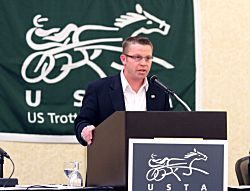USTA Board wraps up annual meetings
March 20, 2012,by John Pawlak, the U.S. Trotting Association
Columbus, OH — Marketing efforts were both debated and unveiled on the final day of the U.S. Trotting Association annual Board of Directors meeting on Monday afternoon (March 19).
The day consisted of final committee meetings and action by the full board on the reports generated by those committees — perhaps the most important of which was the Communications Committee, which heard a presentation presented on behalf of Jeff Gural and about several new programs designed to attract and interest bettors.

Jason Settlemoir presented the results of a recent survey conducted by Jeff Gural.
The results of a recent survey conducted by Tioga, Vernon and Meadowlands operator Jeff Gural was presented by USTA director and Tioga Downs executive Jason Settlemoir. The survey of USTA members in New York, Pennsylvania and Delaware asked if horse owners would be willing to divert one percent of purse money to improved drug testing and one-half of one percent to marketing efforts; the result showed an 84 and 87 percent “yes” response to the questions, respectively.
Settlemoir said that he and Gural had noted that legislatures in Pennsylvania, Indiana and Ontario were poised to raid gaming-produced funds to pay for other state initiatives, which meant that racing needed to be proactive in defending itself. He called for forming a partnership to advance the sport and better ensure its future.
“As quickly as money has been put into the industry (by gaming) it can just as quickly be pulled out (by legislation),” Settlemoir said.
Mike Kimelman, a USTA director and member of the Standardbred Owners Association of New York Board of Directors, demurred: “We’re a long way from instant termination,” he said. “There is no need to panic. At Yonkers, $5 million is already spent on marketing, far more than is being proposed here.”
Sam Beegle, president of the Pennsylvania Harness Horsemen’s Association and USTA director, read a statement expressing the position of his organization and the Meadows Standardbred Association. “Both the Pennsylvania Harness Horsemen’s Association and Meadows Standardbred Owners Association share a longstanding commitment to making a positive contribution to our sport wherever possible. However we are limited by law in terms of the monies we can use for special projects. “The current legislation in Pennsylvania prohibits our groups from using slot revenue for anything but purses with a small portion set aside for health and pension. Any expenses we incur must be paid out of racing revenue. So, even though you may see a big number for total purses, the actual amount available for operating expense is limited. “In spite of those limitations, our organizations have still managed to accomplish a great deal. For instance, we recognize the importance of equine research, especially when it comes to giving guidance to our members about issues like medications. That is why the PHHA and MSOA have contributed over $500,000 to the New Bolton Center in the past three years, alone. “Fair funding was cut recently by the state. Frankly, fairs are the most important grassroots connection we have to many parts of Pennsylvania. That is why our organizations once again stepped in to ensure that fair racing continues This will be a multimillion dollar proposition as we move forward. “One thing both of our organizations recognized immediately was that we have a responsibility to create new fans and reactivate those who have drifted away when Pennsylvania racing was at its lowest point. Both of our organizations have a large monetary commitment to marketing, communications and public relations. We even went so far as to hire fulltime staff to oversee these efforts. To give you one example the PHHA created the Pennsylvania HarnessWeek TV show that airs on Comcast in eastern Pennsylvania, and the ratings for most episodes are comparable to more mainstream sports. “Pennsylvania remains in a budget crisis and it’s impossible to predict what kind of position the PHHA and MSOA will be in next year or the year after that. However, we will continue our efforts as long as they are feasible. We will also give serious consideration to participating in new projects and opportunities as they arise.”
Settlemoir, in his presentation, asked USTA President Phil Langley to name a committee to study the issue, and Langley did just that, tabbing Settlemoir and SOANY President and USTA director Joe Faraldo to join a group of others, to be chaired by Harness Tracks of America President and USTA director Paul Fontaine. Their mission, as directed by Langley, will be to see where the sport stands in terms of the amounts being spent for drug detection and marketing and how and where those amounts are being spent.

USTA/Mark Hall photos
John Hartig of The Daily Racing Form, spoke before the Communications Committee.
John Hartig, representing the USTA’s newest data partner, The Daily Racing Form, announced that the publication, now 118 years old, will make a big push to: “Grow the sport with all of America’s racing fans” by offering exclusive editorial and handicapping content and live event coverage. The Form’s site, www.drf.com, is now filled with content that will appeal to harness and Thoroughbred bettors. Hartig presented data showing that the wagering crossover between the sports is greater than most people think, and represents a possibility for even more growth.
David Siegel, president of TrackMaster and a USTA director, noted his firm will offer several new products in the coming year, including “Best Customer” past performances that will permit harness tracks to give complimentary access to racelines to their most avid bettors; expansion of the Virtual Stable and development of an iPad handicapping product; automated morning lines for racetracks; and online entry conditions — which will aid horsemen in determining where their horses may best fit in a track’s race conditions.
Joe Kristufek of horseplayernow.com announced that his popular “Night School” for Thoroughbred horseplayers will be expanded to harness racing, in cooperation with the U.S. Trotting Association.
“Night School is my passion,” Kristufek said. “Education is grossly neglected. We need to grow fans, and with knowledge comes interest and confidence (in betting).”
Night School presents guest experts who delve deeply into any number of handicapping topics. The lessons are presented live, online, and can later be referred to by students who register for the program.
Before the Board adjourned, it gave final approval to the various committee reports, action on rule change proposals and the organization’s 2012 operating budget. It also agreed to meet next on Feb. 28, 2013 — in Florida as part of the next Harness Racing Congress.
A more complete report on the 2012 Annual Meeting, including the complete text of rule change proposals, will appear in an upcoming issue of Hoof Beats and in the USTA’s Newsroom. The reports of the various committees can be viewed by clicking on this link.
- Day one of USTA Board meeting concludes (Sunday, March 18, 2012)
The Board of Directors of the U.S. Trotting Association, in the 74th anniversary year of the organization’s founding, convened here today for its annual business meetings.
- Full text of the USTA’s position on the use of furosemide (Lasix, Salix) (Tuesday, March 20, 2012)
On Monday, the full Board of Directors of the U.S. Trotting Association approved the organization’s official position on the use of the anti-bleeding medication furosemide, widely known in the racing industry by the trade names Salix and Lasix.
